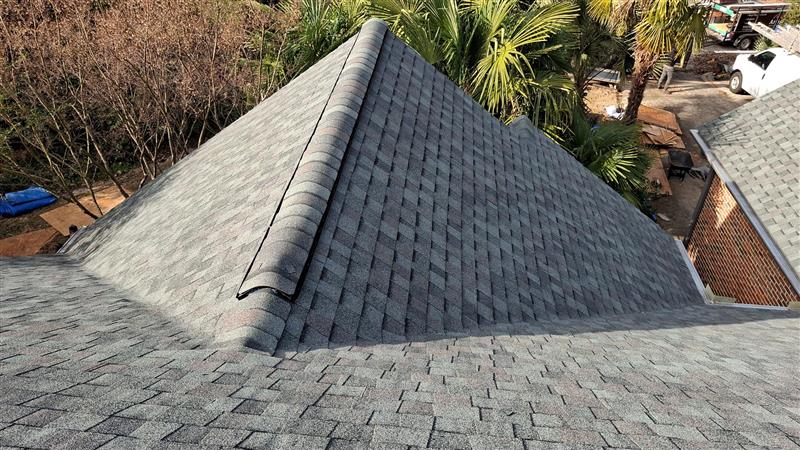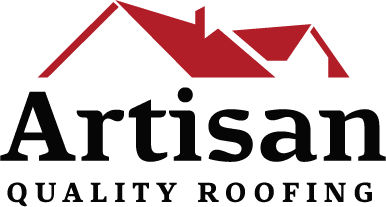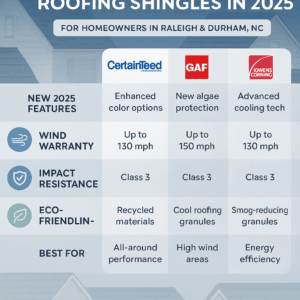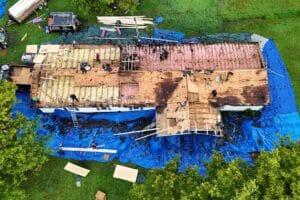We all want a cool, dry attic—so why cut corners with roof ventilation? You’ve invested in quality shingles, underlayment, and flashing, but if air can’t move beneath your roof, you risk shingle failure, soaring energy bills, and even mold. In the Triangle—Apex, Cary, Pittsboro, Raleigh, Durham, and Chapel Hill—your attic needs balanced ventilation to handle humid summers and chilly winters.
What Is Roof Ventilation—and How Should It Work?
Roof ventilation relies on a simple “stack effect”: cool air enters low and hot, moist air escapes high. When done right, this system:
- Draws fresh outside air in through intake vents (soffits and eave vents).
- Channels air past insulation via rigid baffles or AirChutes®.
- Expels heat and moisture through exhaust vents (ridge, gable, turbine, or power vents).
The International Residential Code (IRC) requires 1 sq ft of net-free vent area per 300 sq ft of attic, split evenly between intake and exhaust. Properly engineered airflow flushes blistering heat in summer and tames condensation in winter—essential for Triangle roofs to avoid rot, mold, and ice dams.
Five Key Benefits of Proper Ventilation
- Extended Roof Lifespan Prevents trapped heat from cooking shingles, reducing granule loss and early failure.
- Lower Energy Bills Reduces peak attic temperatures by up to 30%. This helps AC units work better during Apex’s hot months.
- Moisture Control Vents out indoor humidity and weather-driven moisture before it condenses on framing or insulation.
- Ice Dam Prevention Keeps roof decks uniformly cool to stop the freeze–melt–refreeze cycle at your eaves.
- Improved Indoor Comfort Stabilizes attic temperatures, protecting ceilings and HVAC performance year–round.
Beware the Shortcut Roofer
Some contractors skip the hard work of calculating vent ratios and routing baffles. These shortcuts save time but often lead to big problems. Watch for these warning signs:
Blocked or Painted-Over Soffits
Sealing or enclosing soffits for looks blocks fresh air from entering your attic. This makes the space hot and humid, which can lead to mold and wood rot.
Undersized Ridge Vents
Installing only 3–4 ft of ridge vent on a 1,200+ sq ft attic throttles exhaust capacity. Look for continuous ridge vents sized to your attic’s area.
Flimsy Plastic Baffles
Cheap baffles collapse under insulation weight, blocking soffits entirely. Rigid foam or reinforced baffles maintain clear air channels from eaves to ridge.
No Ventilation Calculations
If your roofer does not talk about net-free vent area or attic measurements, they are just guessing. They should follow the IRC’s 1:300 intake-to-exhaust ratio.
Power-Fan “Fixes” Without Intake
Adding an attic fan without checking or adding soffit intake is like using a vacuum with the hose sealed. It pulls air from your living space but still traps heat above.
🚩 Red-Flag Checklist
| Shortcut Move | What to Watch For |
|---|---|
| Blocked Soffits | Eaves sealed or painted over with no visible vents |
| Too-Short Ridge Vent | Less than full-length vent on attics 1,200+ sq ft |
| Flimsy Baffles | Collapsed channels or insulation blocking soffits |
| No Vent Math | No discussion of 1 sq ft per 300 sq ft code ratio |
| Fan-Only Fix | Power vent installed without matching intake vents |
How to Verify Your Ventilation
Before—or after—a roofing project, try this quick home check:
- On a warm day, feel for cool air entering soffits or eave vents.
- Place your hand at ridge or gable vents—you should sense air moving out.
- If airflow is weak or uneven, ask your contractor to show their NFVA calculations and baffle placements.
Frequently Asked Questions
Do I need attic ventilation in winter?
Yes. Everyday activities produce moisture even in cold months—proper airflow prevents condensation, mold, and ice dams.
Can I mix passive and powered vents?
Only if intake is rebalanced. Never let a fan outrun soffits or gable vents, or it will pull conditioned air from living areas.
How much does proper ventilation cost?
A balanced ridge-and-soffit system in the Triangle runs \$300–\$1,000, depending on attic size. Turbines or power vents add \$150–\$500 each.
Proper roof ventilation is the key to a cooler, drier, and longer-lasting roof across the Triangle—Apex, Cary, Durham, Raleigh, and beyond. Artisan Quality Roofing specializes in balanced intake and exhaust solutions tailored to our local climate. Ready to optimize your attic airflow? Schedule your ventilation inspection today at artisanqualityroofing.com/contact or call (919) 906-3791

Roof ventilation shouldn’t have short cuts



